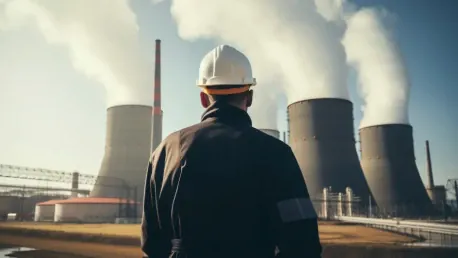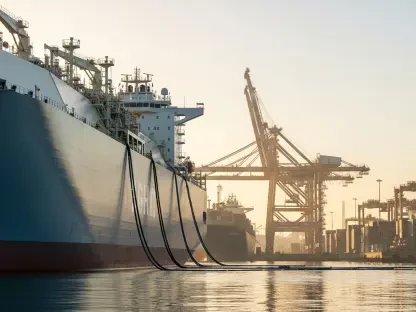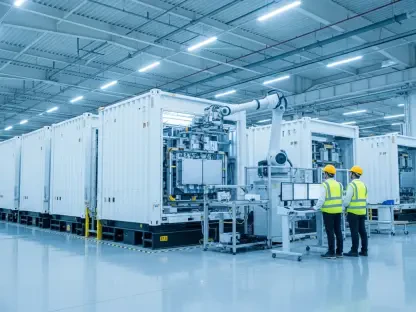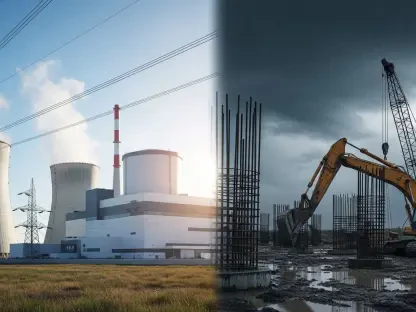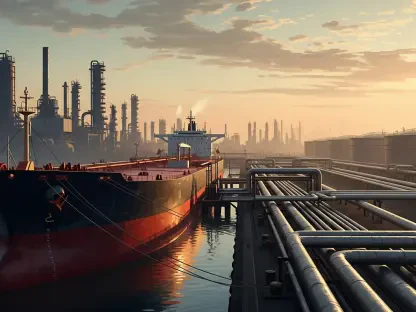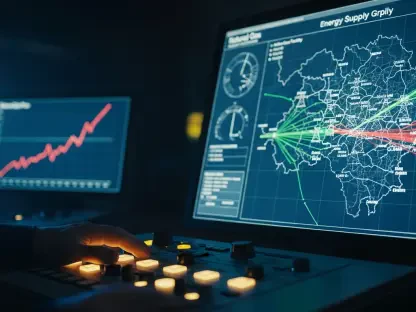The construction of nuclear power plants is a complex and highly regulated process, designed to ensure the utmost safety and security. Adhering to stringent safety regulations is paramount to mitigating potential threats posed by environmental and human-induced hazards. This article delves into the various aspects of these regulations and the critical importance of compliance.
Regulatory Frameworks
International and National Regulatory Bodies
The International Atomic Energy Agency (IAEA) plays a crucial role in establishing global safety frameworks and providing technical guidance on reactor construction and operations. This international body sets forth standards that ensure countries adhere to the safest practices in the development and operation of nuclear facilities. Meanwhile, individual nations have their own regulatory agencies that enforce these standards and tailor them to their unique contexts. Institutions like the UK’s Office for Nuclear Regulation, the U.S. Nuclear Regulatory Commission, and the European Nuclear Safety Regulators Group directly oversee the safety of nuclear facilities within their respective jurisdictions, ensuring that each plant meets local safety requirements.
These regulatory bodies operate with a level of scrutiny that leaves little to chance. They perform regular inspections, evaluate operational data, and enforce compliance through stringent procedures. Additionally, the World Association of Nuclear Operators (WANO) facilitates the sharing of best practices and experiences between operators worldwide. WANO promotes operational excellence by encouraging peer reviews that identify and mitigate potential risks before they escalate. The combined efforts of international and national bodies form a multi-layered web of oversight that ensures nuclear plants are among the most secure infrastructures ever constructed.
The SEC’s Cautious Approach and Call for Public Comment
In its deliberate approach to addressing the complexities of cryptocurrencies, the SEC opted for another delay in its verdict on the spot Ethereum ETF. The extension grants the SEC an opportunity not only to conduct an in-depth examination of Ethereum’s suitability for ETF status but also to source public insight, which could heavily sway the conclusion. This speaks to the SEC’s attentiveness to the nuances of digital assets and their integration into regulatory frameworks, which it does not take lightly. The situation closely parallels the stalling faced by Grayscale, who is also waiting for the green light to transform its Ethereum Trust into a spot ETF, raising questions about the contrasting regulatory processes for Bitcoin and Ethereum.
Importance of Compliance
Compliance with these multi-layered regulations is essential to ensure the safety and security of nuclear power plants. These regulations are designed to address a wide range of potential hazards, both natural and human-induced, and to ensure that nuclear facilities operate safely and reliably. Non-compliance is not merely a bureaucratic issue but could pose significant risks to public health and safety. Strict adherence to guidelines limits the chances of operational failures that could lead to catastrophic events, ensuring that nuclear energy remains a safe and viable option for meeting global energy needs.
Staying within the guidelines established by regulatory bodies requires an ongoing commitment to excellence. Regular audits and inspections help to maintain vigilance, continuously verify compliance, and adapt to emerging threats. Moreover, the international nature of oversight ensures that lessons learned from past incidents worldwide, such as the accidents at Chernobyl and Fukushima, are incorporated into the evolving body of regulations. This collaborative global oversight makes compliance not just a legal requirement but a shared ethical responsibility among all stakeholders involved in nuclear energy.
Hazard Management in Nuclear Power Plant Construction
Identifying and Assessing Risks
In the construction of nuclear power plants, identifying and assessing potential hazards is crucial to ensure safety and minimize risks to workers and the environment. This involves detailed risk assessments, planning, and coordination with regulatory bodies to adhere to stringent safety standards.
Implementing Safety Measures
Once risks are identified, implementing comprehensive safety measures is essential. This includes using advanced technology for real-time monitoring, training staff on safety protocols, and maintaining strict access control to sensitive areas. Regular safety drills and inspections are also conducted to ensure preparedness for any emergency situations.
Collaboration and Communication
Effective hazard management relies heavily on collaboration and communication among all stakeholders involved in the construction process. Ensuring clear and consistent communication channels helps in addressing issues promptly and maintaining a high level of safety awareness among the team members.
Natural Hazards
Natural hazards such as seismic activities, meteorological events, and extreme temperature variations pose significant risks to nuclear power plants. Seismic activities like earthquakes and landslides can impact the structural integrity of the plant, while meteorological events such as storms, winds, floods, and tsunamis can affect plant operations and safety. Extreme temperature variations can also impact the plant’s systems and components. To mitigate these risks, comprehensive geological and meteorological studies are conducted long before the first concrete is poured. These studies guide the design of the plant, ensuring it can withstand the most extreme natural conditions likely to occur in its location.
Advances in engineering have significantly improved our ability to deal with natural hazards. Earthquake-resistant structures, for example, incorporate flexible designs and advanced materials that can absorb and distribute seismic energy, reducing the chance of catastrophic failure. Flood defenses, including elevated platforms and reinforced seawalls, help protect against rising water levels. Climate control systems are designed to handle extreme temperature variations, ensuring the continuous safe operation of critical components. These engineering solutions, combined with constant monitoring and detailed emergency planning, form a comprehensive strategy to manage natural hazards effectively.
Human-Induced Hazards
Human-induced hazards include risks from external impacts like explosions and aircraft crashes, as well as cybersecurity threats such as malware or ransomware attacks. The security landscape for nuclear facilities has evolved to counter these threats, integrating both physical and digital safeguards. Hardened structures designed to withstand explosions and other forms of physical attacks are integral to the plant’s construction, providing a robust first line of defense. Additionally, no-fly zones and advanced radar systems help protect against aircraft crashes, significantly reducing the chances of such incidents occurring.
In today’s digital age, cybersecurity is as critical as physical security in protecting nuclear plants. Cyber-attacks can come from various sources, including state-sponsored hackers and rogue entities, aiming to disrupt operations or steal sensitive information. Advanced cybersecurity measures are in place to safeguard the plant’s networks and control systems. These include multi-layered firewalls, intrusion detection systems, and regular security audits to identify and address vulnerabilities. Comprehensive training programs ensure that staff are well-versed in the latest cybersecurity practices, making human error less likely. Together, these measures offer a robust defense against the range of human-induced hazards that nuclear power plants may face.
Site Selection and Licensing Requirements
Criteria for Location Selection
Selecting a suitable site for a nuclear power plant involves thorough assessments to ensure resistance to earthquakes and other ground movements. Soil integrity assessments are conducted to prevent structural failure, and hydrological studies ensure a stable water source for water-cooled reactors. The site selection process is rigorous and multifaceted. Factors like population density, proximity to existing infrastructure, and long-term environmental impact are considered. These criteria help ensure that the chosen site will support safe and efficient operations over the plant’s expected lifespan.
The geographical and geological characteristics of a potential site are critical factors in its selection. Areas prone to seismic activity are often avoided unless advanced engineering solutions can be implemented to mitigate the risks. The site’s accessibility to reliable sources of cooling water is another essential consideration. For instance, sites near large bodies of water are often preferred due to the abundance and reliability of the water supply, which is vital for cooling nuclear reactors. The selection process emphasizes creating an environment where the plant can operate safely under both normal and adverse conditions.
Environmental Impact Assessments (EIAs)
Comprehensive Environmental Impact Assessments (EIAs) are mandated to evaluate the effects on local ecosystems, air, and groundwater. Regulatory bodies must approve these assessments before construction can begin, ensuring that the environmental impact is minimized. EIAs consider a wide range of factors, including the potential impact on local wildlife, vegetation, and natural habitats. They also assess how the plant’s operations might affect air quality and water sources. The goal is to identify and mitigate any adverse environmental effects, ensuring the long-term sustainability of the project.
The EIA process is not merely a formality but a rigorous examination that often involves multiple stakeholders, including environmental groups, local communities, and scientific experts. Public consultations are typically part of the process, ensuring that local concerns are heard and addressed. The findings from the EIA guide the design and operational plans for the plant, incorporating measures to minimize any negative environmental impacts. This comprehensive approach ensures that the plant operates in harmony with its surroundings, maintaining the balance between meeting energy needs and protecting the environment.
Licensing Process
The licensing process involves thorough consultation with environmental agencies, government departments, and public committees. Once the licensing is approved, construction permits are issued, allowing the project to proceed. This multi-step process ensures that all potential risks are evaluated and mitigated before construction begins. Licensing requirements vary by country but generally include detailed safety analyses, emergency preparedness plans, and long-term waste management strategies. These measures ensure that the plant will operate safely and comply with all relevant regulations.
Obtaining a license is a rigorous and lengthy process, often taking several years to complete. Each step in the process is designed to ensure that the plant will meet the highest safety and environmental standards. Public transparency and community involvement are key aspects of the licensing process, helping to build trust and acceptance among local populations. The culmination of these efforts is a construction permit that signifies regulatory approval and the green light to proceed. This exhaustive process underscores the critical importance of safety and regulatory compliance in the construction of nuclear power plants.
Design and Engineering Safety Standards
Integrated Safety Approach
An integrated safety approach employs multiple layers of protection (defense-in-depth) to manage unforeseen risks. Engineering redundancy on core components ensures resilience against stress and failures, with robust structural designs to withstand extreme external forces. This multi-layered strategy is fundamental to the design and engineering of nuclear power plants. It involves the implementation of diverse, redundant safety systems designed to prevent accidents and mitigate their consequences should they occur. These systems include multiple cooling mechanisms, emergency power supplies, and containment structures.
The defense-in-depth philosophy extends beyond the physical design of the plant to include operational procedures and safety protocols. Regular drills and training exercises ensure that staff are prepared to respond effectively to emergencies. Safety culture, which emphasizes proactive risk management and continuous improvement, is deeply ingrained in the operational processes. Redundancy and diversity are key principles, ensuring that no single failure can compromise the plant’s safety. This comprehensive approach ensures that the plant can handle a wide range of potential hazards, from equipment malfunctions to natural disasters.
Advanced Technologies
In an effort to restore confidence in America’s banking system, the US government has provided assurance that customers of the failed Silicon Valley Bank (SVB) will be able to access all of their funds beginning on Monday. This move is part of a broader strategy to stabilize the financial sector and bolster public trust in the banking system.
Technologies such as passive cooling and automated emergency shutdown mechanisms that operate without power add to the plant’s accident resilience. These advanced technologies are critical in ensuring the safety and reliability of nuclear power plants. Passive cooling systems rely on natural circulation to remove heat from the reactor, eliminating the need for external power sources. In the event of a power loss, these systems can continue to operate, providing a fail-safe mechanism to prevent overheating. Automated emergency shutdown systems can quickly and safely shut down the reactor in response to predefined conditions, ensuring a rapid response to potential threats.
Advanced manufacturing techniques and materials science also play a significant role in enhancing the safety of nuclear power plants. High-strength alloys and composite materials offer enhanced durability and resistance to stress and corrosion. State-of-the-art monitoring systems provide real-time data on plant operations, enabling early detection of potential issues. Innovations in waste management technologies, such as advanced containment systems and recycling methods, reduce the environmental impact of nuclear waste. These technological advancements represent a significant step forward in ensuring that nuclear power remains a safe and sustainable energy source for the future.
Construction Safety Protocols
Construction safety protocols are crucial for ensuring the well-being of workers and preventing accidents on job sites. These protocols include mandatory training, the use of personal protective equipment (PPE), regular safety inspections, and adherence to guidelines set by regulatory bodies. Proper training helps workers recognize potential hazards and implement safety measures. Utilizing PPE, such as helmets, gloves, and safety harnesses, minimizes injury risks. Conducting regular safety inspections ensures that equipment and site conditions meet safety standards. Compliance with regulations from entities like OSHA ensures a standardized approach to safety across the industry, ultimately protecting workers and fostering a culture of safety.
Rigorous Testing and Protective Measures
Adherence to extreme safety measures during construction is crucial to meet design specifications and regulatory standards. Rigorous testing of construction materials and protective measures to shield against radiation are essential components of the construction process. Construction materials undergo an extensive series of tests to ensure they meet the highest standards for strength and durability. These tests include ultrasonic and radiographic examinations to check for internal defects, ensuring that every component will perform reliably under stress. Special attention is given to materials used in critical areas of the plant, such as reactor pressure vessels and containment structures.
In addition to material testing, protective measures are implemented to protect workers and the environment from radiation exposure. These measures include using lead shielding, maintaining safe work distances, and implementing strict protocols for handling radioactive materials. Personal protective equipment (PPE) is mandated for all personnel, and specialized training is required to ensure that everyone on site understands and complies with these safety measures. The goal is to create a construction environment where the safety of workers and the integrity of the plant are never compromised.
Regulatory Inspections
Regulatory inspectors are involved throughout the construction stages, ensuring compliance with approved designs. Any deviations must be immediately addressed to prevent potential safety issues. Inspectors conduct regular site visits, reviewing construction progress and verifying that all work meets regulatory standards. They have the authority to halt construction if any issues are identified, ensuring that problems are addressed before they can escalate. This ongoing oversight provides an additional layer of assurance that the plant will be built to the highest safety standards.
The role of regulatory inspectors extends beyond mere compliance checks. They also serve as a valuable resource for identifying best practices and promoting continuous improvement. By sharing insights and recommendations, inspectors help construction teams enhance their procedures and adopt more effective safety measures. This collaborative approach ensures that construction meets all regulatory requirements and benefits from the latest advancements in safety and engineering practices. The involvement of inspectors from start to finish underscores the rigorous oversight that characterizes the construction of nuclear power plants.
Seismic and Natural Disaster Considerations
Lessons from Past Incidents
Lessons from past incidents like the Fukushima Daiichi reactor disaster have informed modern regulations. Elevated construction platforms, reinforced seawalls, flexible piping systems, and robust anchorage are implemented to ensure that construction damage does not lead to malfunctions. The Fukushima disaster underscored the need for comprehensive defenses against extreme natural events. In response, regulations now require higher standards for flood protection, including elevated foundations and improved drainage systems. Seawalls are designed to withstand the highest possible tidal waves, and flexible piping systems are used to accommodate ground movement without rupturing.
The lessons learned from Fukushima have also led to improvements in emergency planning and response. Plants are now required to have more robust backup systems and better coordination with local emergency services. Drills and simulations are conducted regularly to ensure that staff and local responders are prepared for a wide range of scenarios. These measures help to build resilience, ensuring that even in the face of natural disasters, nuclear plants can maintain their integrity and protect public safety. The Fukushima incident serves as a powerful reminder of the need for constant vigilance and continuous improvement in the face of evolving threats.
Robust Infrastructure
The Chernobyl disaster highlights the consequences of inadequate infrastructure and design. Modern nuclear power plants use fire-resistant materials, automatic fire suppression systems, and thorough containment protocols to prevent similar incidents. The Chernobyl accident exposed critical weaknesses in reactor design and operational procedures, leading to widespread reforms in both areas. Today’s reactors are designed with multiple layers of containment to prevent the release of radioactive materials, even in the event of a severe accident. Fire-resistant materials are used throughout the plant, and advanced fire suppression systems are installed to quickly extinguish any fires that occur.
Thorough containment protocols are also a key component of modern plant design. These protocols include multiple barriers to contain radioactive materials, as well as systems for monitoring and controlling radiation levels. In the event of an incident, automated systems can quickly isolate affected areas and prevent the spread of contamination. Continuous monitoring ensures that any potential issues are detected early, allowing for prompt intervention. The advancements in infrastructure and design are a direct response to the lessons learned from Chernobyl, ensuring that modern plants operate with the highest levels of safety and reliability.
Security Measures
Preventing Sabotage and Unauthorized Access
Security in nuclear construction is integral, with measures to prevent sabotage and unauthorized access. Digital security protocols counter hacking and ransomware threats, which have grown exponentially in recent years. Physical security measures include fencing, surveillance systems, and access controls to protect the construction site from intruders. Digital security measures are equally stringent, incorporating multi-layered firewalls, intrusion detection systems, and regular security audits. These measures ensure that the plant’s systems and data are protected from cyber threats, which have become increasingly sophisticated and pervasive.
The security measures extend to the design and construction of the plant itself. Hardened structures are built to withstand attacks, and critical systems are segregated to prevent a single point of failure. Access to sensitive areas is strictly controlled, with multiple layers of authentication required. These measures create a robust security environment that deters potential threats and ensures that the plant can operate safely. The integration of physical and digital security measures is essential in creating a comprehensive defense against the wide range of threats that nuclear plants face.
Stringent Background Checks and Monitoring
Workers undergo stringent background checks, and site security includes fencing, checkpoints, and round-the-clock monitoring systems to ensure the safety and security of the construction site. Background checks help ensure that only trusted individuals have access to the site, minimizing the risk of sabotage or insider threats. Security personnel conduct regular patrols and monitor surveillance systems to detect and respond to any suspicious activity. Checkpoints control access to the site, ensuring that only authorized personnel can enter.
The security measures also include continuous training and drills to ensure that all personnel are prepared to respond to potential security incidents. These drills simulate various scenarios, from physical intrusions to cyber-attacks, helping to identify vulnerabilities and improve response procedures. The goal is to create a security culture where everyone on site is vigilant and proactive in protecting the plant. By combining robust security measures with continuous training and monitoring, modern nuclear plants can maintain a high level of security throughout the construction process.
Waste Management and Environmental Protection
Handling and Storing Radioactive Materials
Handling, storing, and removing radioactive materials according to specialized protocols is vital to mitigate environmental impact. Containment measures prevent contamination of local water bodies and soil, backed by frequent testing to ensure regulatory compliance. Specialized containers are used to store radioactive materials, designed to prevent leaks and withstand extreme conditions. These containers are regularly inspected to ensure their integrity, and any materials that show signs of wear are promptly replaced. The goal is to minimize the risk of environmental contamination and protect public health.
Removing radioactive waste is equally critical, and specialized facilities are used to handle and process these materials. Waste is often processed to reduce its volume and toxicity, making it easier to store and manage. Long-term storage solutions, such as deep geological repositories, provide secure containment for waste that remains hazardous for extended periods. Regular monitoring and testing ensure that these storage facilities remain safe and secure, preventing any leaks or contamination. By following these stringent protocols, nuclear plants can manage their waste responsibly and protect the environment.
Environmental Protection Measures
Environmental protection measures are implemented throughout the construction process to minimize the impact on local ecosystems. These measures are essential in ensuring the long-term sustainability of nuclear power plants. Construction activities are carefully planned to avoid disturbing local wildlife and natural habitats. Measures such as erosion control, habitat restoration, and water management help mitigate the impact of construction on the environment. These efforts ensure that the plant can coexist with its surroundings, maintaining the balance between development and conservation.
Continuous environmental monitoring is conducted to ensure that the plant’s operations do not adversely affect the local environment. Air and water quality are regularly tested, and any deviations from regulatory standards are promptly addressed. These monitoring efforts help identify potential issues early, allowing for quick intervention. The goal is to ensure that the plant operates sustainably, minimizing its environmental footprint while providing reliable energy. By implementing comprehensive environmental protection measures, nuclear plants can achieve a balance between meeting energy needs and preserving the natural environment.
Oversight and Inspections
Continuous Monitoring and Regular Inspections
Regular inspections and continuous monitoring are essential in maintaining the safety and efficiency of various systems and infrastructures. These measures help identify potential issues before they escalate, ensuring timely interventions and minimizing risks. By implementing consistent check-ups and assessments, organizations can maintain operational standards and improve overall performance.
Continuous monitoring and regular inspections form the cornerstone of construction stages. Various regulatory bodies oversee daily construction activities, ensuring strict adherence to safety standards. This ongoing oversight involves detailed inspections of materials, work practices, and progress to verify compliance with approved designs and procedures. Each phase of construction requires passing rigorous safety testing before moving forward, with even minor breaches being addressed promptly to prevent escalation.
Inspectors conduct regular site visits to review construction progress and verify compliance with all regulatory requirements. They have the authority to halt construction if any issues are identified, ensuring that problems are addressed before they can escalate. This ongoing oversight helps ensure that the plant will be built to the highest safety standards. The role of inspectors extends beyond merely identifying compliance issues; they also help identify best practices and promote continuous improvement. By sharing insights and recommendations, inspectors help construction teams enhance their procedures and adopt more effective safety measures.
Regular and surprise audits ensure that the construction process remains transparent and that all stakeholders are held accountable for maintaining the highest standards of safety and quality. These rigorous inspections help create a culture of continuous improvement, where lessons learned are integrated into future practices. This thorough oversight ensures that nuclear plants are built to the highest safety and engineering standards, minimizing the risk of accidents and ensuring the long-term reliability of the plant.
Final Thoughts
The SEC’s cautious approach demonstrates its commitment to thoroughly understanding the implications of integrating digital assets like Ethereum into regulated financial products. This meticulous process, while causing delays, underscores the importance of comprehensive regulatory scrutiny in the rapidly evolving landscape of cryptocurrencies. The outcome will likely set a precedent for how such assets are managed in the future, impacting both market participants and the broader financial ecosystem.
The construction of nuclear power plants is an intricate and meticulously regulated endeavor, aiming to guarantee the highest levels of safety and security. It is vital to adhere strictly to these stringent safety regulations to alleviate potential risks arising from environmental factors and human activities. This article explores various facets of these regulations and underscores the critical importance of compliance.
Building a nuclear power facility involves numerous technical and safety protocols designed to protect both the environment and the population. The regulatory framework governing these plants spans multiple stages, from initial design to construction and operation, ensuring that every aspect of the plant meets rigorous safety standards. This comprehensive approach helps address potential hazards, including natural disasters, equipment malfunctions, and human errors.
The enforcement of such rigorous regulations is crucial for preventing incidents that could have catastrophic consequences. International bodies like the International Atomic Energy Agency (IAEA) and national entities set and monitor these standards, reflecting a global commitment to nuclear safety. Compliance with these regulations involves regular inspections, audits, and continuous monitoring to identify and mitigate any potential risks.
In summary, the complex and highly regulated process of constructing nuclear power plants is fundamental in maintaining safety and security. Adhering to stringent safety regulations is essential for mitigating environmental and human-induced threats, ensuring the safe operation of these critical energy sources.
